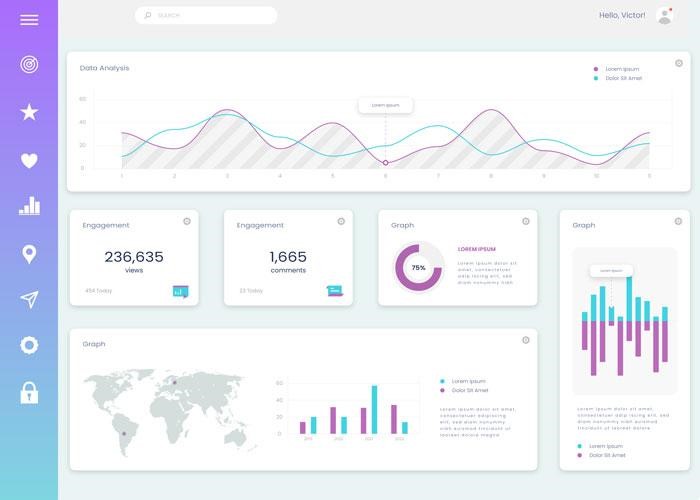
Real-Time Business Intelligence (RTBI) lets users access the information that happened recently via a dashboard. The recent information can be an event that occurred a few milliseconds ago or before an hour. The latency of this data depends on the analytical purpose. For marketing, the latency must be of least value.
Google Analytics is an example that provides real-time website tracking with high accuracy and the least latency rate. The above scenario defines the importance of real-time data analysis, however, Business Intelligence (BI) itself is an advanced tool to analyze the data.
Understanding real-time business intelligence concept
Google analytics provides user interactive data based on website behavior, but BI analyzes data based on the entire business information. Business intelligence can be defined as a collective data-driven process to analyze the business data and generate actionable insights that help decision-makers make smart decisions.
Customer and employee behavior can be analyzed from BI tools. Different Key Performance Indicators (KPIs) are analyzed to make new strategies that help a company focus on low performing business metrics. Various tools and methodologies are used for data analysis, such as data visualizations which is then presented to end-users with data. With data visualization, the end-users can easily analyze the data using different chart-like representations.
Real-time data can be easily accessed from a BI-powered dashboard. Alongside, the historic data analysis can be made to find trends as well as compare it with real-time data to analyze the performance of the company.
Here is a BI dashboard that helps companies to analyze their real-time data, business trends, KPI cards, historic analysis and much more represented using data visualization techniques.
10 reasons why RTBI should be considered to improve customer acquisition and retention
As discussed earlier, different KPIs can be analyzed in an RTBI dashboard and represented in the dashboard as KPI cards. Actually, accessing and analyzing these KPI cards based on customer behavior is the goal of integrating business intelligence. So, let’s see the 10 major reasons why one must consider introducing real-time business intelligence and how it effectively handles customer acquisition and retention.
- Analyze every tiny detail from your business data: With BI, it’s easier to analyze every hidden detail from your data. All you have to do is feed all the business data because the insights are made based on the data provided by you.
- From raw data to structured data: The primary data from business sources are refined and modified into useful formats using different data labels. That is, raw data is converted into a structured form which is then easier for data analysis.
- Avoid bottlenecks on your business: Some delays may occur in your business flow which eventually affects the entire business process. Delays caused by bottlenecks can be identified and solutions can be made accordingly.
- Connect three phases of your business: It is important to track your business progress by comparing three phases—past, present, and future. Comparing past and present events or data for the future is one of the key factors for business growth.
- Find business trends from time-to-time: Trends keeps attracting more prospects and gives direction in the course of your business. With historic analysis, business trends can be analyzed and your business becomes aware of the changing ways in the industry.
- Visually appealing data representation: If the data is represented in a way that is hard for you to digest then it’s a failure! Data reports and values represented with visually appealing data charts, maps, etc. helps you to understand the significance of your own business data.
- Demand forecasting: Based on the data, the system will predict customer demand (predictive analysis) and optimize supply decisions. Market analysis will also be carried out using methods like qualitative and quantitative assessments.
- Customer behavioral analysis: The most vital part of BI tools is to analyze customer behavior analysis based on different factors. The actionable data gives accurate information about customers, that help you make the right consumer segments.
- Build strategies to improve low-running fuels of your business: The low performing business metrics can be analyzed based on the value of KPI cards. Business strategies can be built to improve these areas.
- Make smart decisions using data-driven methods: Instead of making decisions based on assumptions, make smart decisions backed with proper data. The insights generated from the data analysis are thus very useful to improve decision-making skills.
By following these methods, make an effective customer acquisition as well as improve customer retention. Let me conclude this article by providing some stats that give you awareness on why customer retention is important?
- If an existing customer loves a company’s product then there is a 60% probability that they are likely to make another purchase from the same company (Marketing Metrics).
- Organizations that follow data-driven approaches are 23 times more likely to acquire customers, 6 times to retain customers, and 19 times more likely to make a profit (Mckinsey Global Institute).
- Businesses that follow on data-driven insights are growing 30% on average each year and are likely to take $1.8 trillion from the less-informed competitors (fifth insight).
So, what do you think? Isn’t this the right time to implement business intelligence into your business and earn more prospects?

